Favorite Geysers
Do you come to Yellowstone for the first time? Many first time visitors are overwhelmed by the vast amount of thermal features. So, for a given duration of your stay, which of the more than 300 active geysers are most worthwhile to visit?
Well, except for the "Big Five" there is no plain answer. It depends on what experience you are looking for. Is it the thrill of sudden, tall geyser eruptions at almost no waiting time? Or the contemplative gazing at a geyser in expectation of a rare eruption event? Or the wonder of gorgeous, sometimes bizarre sinter formations? Or the ecstasy of vibrant color contrasts arising from communities of thermophile organisms? Would you like to combine all this with strolls on paved trails through a wonderland of nature, or do you prefer hikes into the wild, pristine backcountry? If you rely on recommendations of hiking websites, you will most likely end up in the tourist crowd and only see what everybody else sees. It’s better to make your own choice.
The Big Five
The "Big Five" are the embodiment of Yellowstone’s geysers par excellence. Their tall jets and frequent, at least daily activity have made them famous all over the world. For the "Big Five" you will find eruption predictions on a regular basis at the visitor center, on the internet, or as app, even though the prediction for Great Fountain may not always be available due to a lack of observation data. Based on the predicted eruption times you may schedule your visit accordingly. But don’t expect to see them all playing within only one day, even if the predicted times occasionally may imply so. Predictions can not be absolutely precise, and the unpunctuality you have to take into account varies from geyser to geyser (see "How do geysers work?"). Each of the "Big Five" is easy to reach from parking lots within half an hour or less walking on paved trails, but close to the predicted eruption times they are also very crowded from 9 to 5 o'clock during the main season.
- Old Faithful Geyser (interval usually between 1 and 1.5 hours; eruption height up to 56 m (185 feet); 0.2 km / 0.1 miles from Old Faithful parking lot, Upper Geyser Basin)
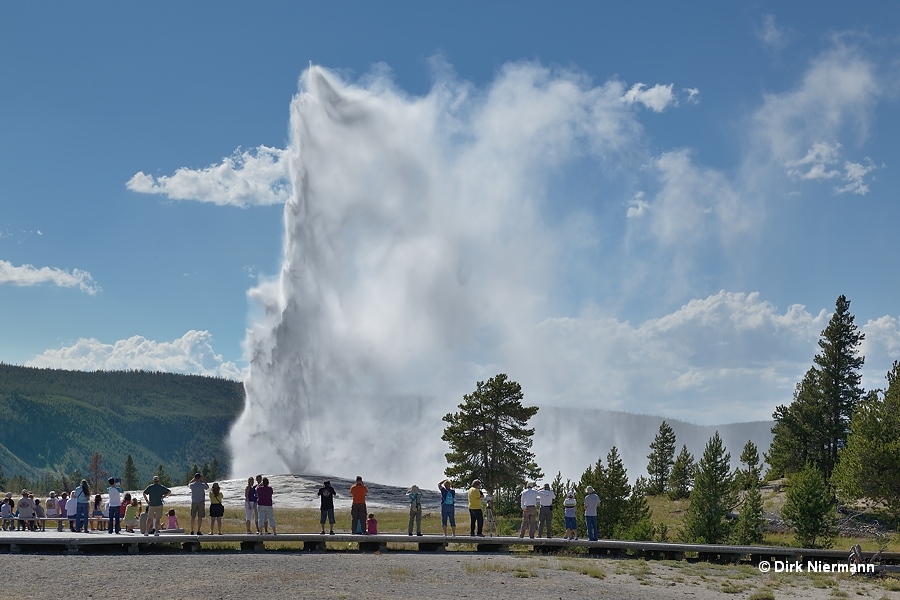
- Grand Geyser (interval usually between 5.5 and 9.5 hours; eruption height up to 55 m (180 feet); 1.4 km / 0.8 miles from Old Faithful parking lot, Upper Geyser Basin)
- Castle Geyser (interval usually between 10 and 13 hours; eruption height up to 30 m (100 feet), 1 km / 0.6 miles from Old Faithful parking lot, Upper Geyser Basin)
- Daisy Geyser (interval usually between 2 and 3 hours; eruption height up to 23 m (75 feet); 1.3 km / 0.8 miles from Old Faithful parking lot, Upper Geyser Basin)
- Great Fountain Geyser (interval usually between 8 and 15 hours; eruption height up to 70 m (230 feet); next to Great Fountain parking lot, Lower Geyser Basin)
Insider Favorites
The list holds large and spectacular geysers, regularly active, but except for Riverside Geyser they are usually not predicted by the visitor center because dependencies are too complex or information is missing for other reason. Without insider knowledge you may face frustratingly long waiting times. However, it’s a promising sign if you see in front of the feature some geysers gazers (look for observers with walkie-talkies and writing pads), who often do know a little bit more than the ranger on duty at the park’s visitor center.
- Pink Cone Geyser (interval usually between 18 and 23 hours; eruption height up to 9 m (30 feet); next to Pink Cone Group roadway turnout, Lower Geyser Basin)
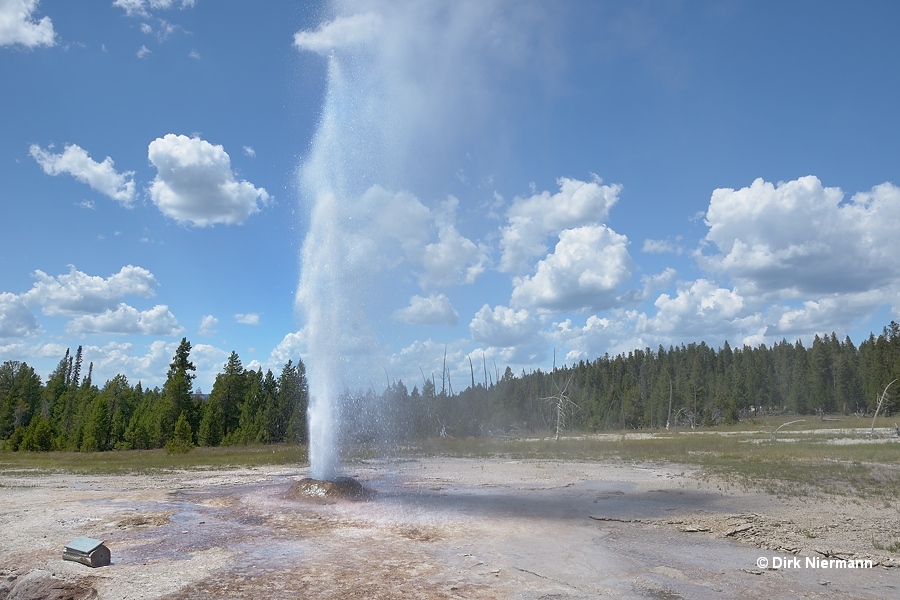
- Beehive Geyser (interval usually between 10 and 20 hours; eruption height up to 60 m (200 feet); 0.8 km / 0.5 miles from Old Faithful parking lot, Upper Geyser Basin)
- Fountain Geyser (interval usually between 3.5 and 7.5 hours; eruption height up to 15 m (50 feet); 0.4 km / 0.3 miles from Fountain Paint Pot parking lot, Lower Geyser Basin)
- Riverside Geyser (interval usually between 6 and 7 hours; eruption height up to 23 m (75 feet); 2.2 km / 1.4 miles from Old Faithful parking lot, Upper Geyser Basin)
- Lion Geyser (interval usually between 4 and 10 hours; eruption height up to 20 m (70 feet); 1 km / 0.6 miles from Old Faithful parking lot, Upper Geyser Basin)
- Artemisia Geyser (interval usually between 9 and 34 hours; eruption height up to 9 m (30 feet); 0.7 km / 0.4 miles from Biscuit Basin parking lot, Upper Geyser Basin)
- Atomizer Geyser (interval usually between 12 and 16 hours; eruption height up to 15 m (50 feet); 0.7 km / 0.4 miles from Biscuit Basin parking lot, Upper Geyser Basin)
- Aurum Geyser (interval usually between 2.5 and 14 hours; eruption height up to 7 m (25 feet); 1 km / 0.6 miles from Old Faithful parking lot, Upper Geyser Basin)
- Lone Star Geyser (interval usually between 2.5 and 3.5 hours; eruption height up to 14 m (45 feet); 4 km / 2.5 miles from Kepler Cascades parking lot, Lone Star Geyser Basin)
Fun Geysers
They aren‘t the big shots but the clowns and entertainers among Yellowstone’s geysers. Featuring small to medium sized eruptions, these geysers don’t need any prediction because they are very frequently active. Moreover, all of them are easy to reach and to be observed from quite a close distance.
- Anemone Geysers (eruption height up to 3 m (10 feet); 0.8 km / 0.5 miles from Old Faithful parking lot, Upper Geyser Basin)
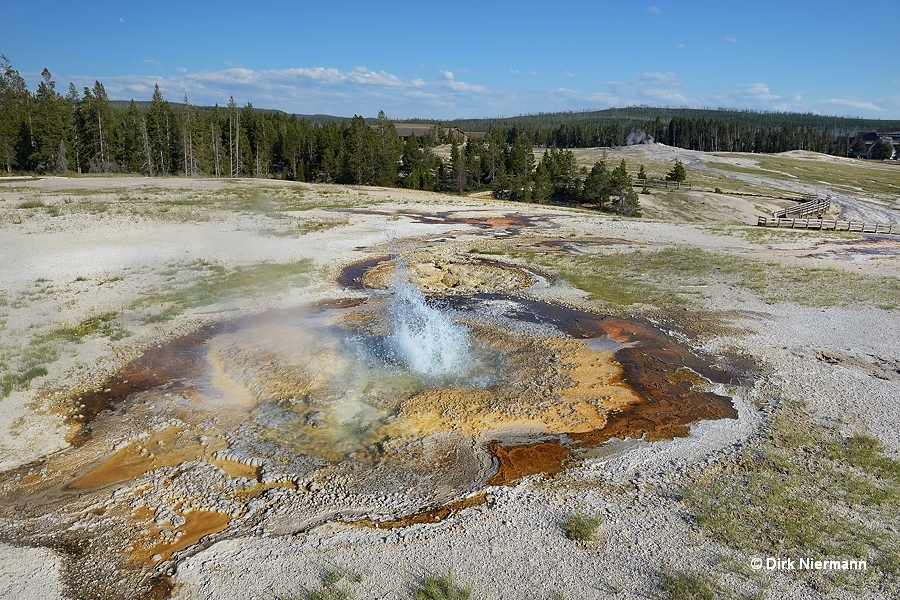
- Pump Geyser (eruption height up to 3 m (10 feet); 0.9 km / 0.6 miles from Old Faithful parking lot, Upper Geyser Basin)
- Sawmill Geyser and Spasmodic Geyser (Sawmill eruption height up to 10 m (33 feet); 1.2 km / 0.7 miles from Old Faithful parking lot, Upper Geyser Basin)
- Bank Geyser and Comet Geyser (eruption heights up to 3 m (10 feet); 1.3 km / 0.8 miles from Old Faithful parking lot, Upper Geyser Basin)
- Flood Geyser (eruption height up to 7 m (25 feet); next to Flood Group parking lot, Midway Geyser Basin)
- Jewel Geyser (eruption height up to 6 m (20 feet); 0.3 km / 0.2 miles from Biscuit Basin parking lot, Upper Geyser Basin)
- Rusty Geyser (eruption height up to 3 m (10 feet); next to Biscuit Basin parking lot, Upper Geyser Basin)
- Spouter Geyser and Cliff Geyser (Cliff eruption height up to 12 m (40 feet); next to Black Sand Basin parking lot, Upper Geyser Basin)
- Clepsydra Geyser (eruption height up to 12 m (40 feet); 0.4 km / 0.3 miles from Fountain Paint Pot parking lot, Lower Geyser Basin)
- White Dome Geyser (eruption height up to 9 m (30 feet); next to White Dome parking lot, Lower Geyser Basin)
- Artesia Geyser and Young Hopeful Geyser (Artesia eruption height up to 3 m (10 feet); next to Hot Lake parking lot, Lower Geyser Basin)
Ones of their kind
Not necessarily geysers, these unique features are unparalleled around the world. Their mystic appearance will give you the impression of walking on a planet of a different solar system. Most are easy and safe to reach, but the last two are backcountry features and require an experienced guide.
- Dragon's Mouth Spring (0.1 km / 0.1 miles from Mud Volcano parking lot, Hayden Valley Geyser Basin)
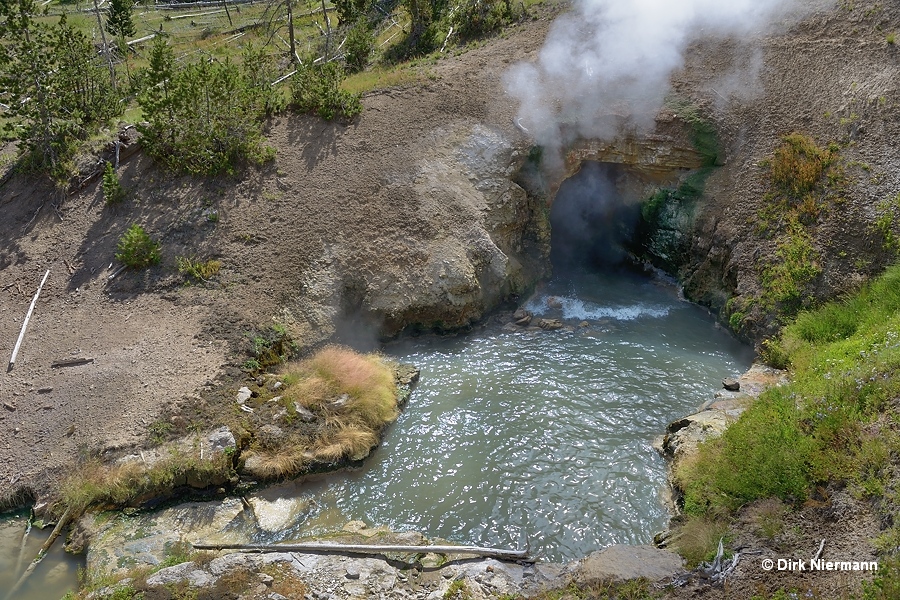
- Green Dragon Spring (1 km / 0.6 miles from Norris Geyser Basin parking lot)
- Grotto Geyser (eruption height up to 12 m (40 feet); 2 km / 1.3 miles from Old Faithful parking lot, Upper Geyser Basin)
- Monument Geyser (1.7 km / 1 mile from Monument Geyser Basin parking lot, Gibbon Geyser Basin)
- Chocolate Pots (next to Chocolate Pots roadway turnout, Gibbon Geyser Basin)
- Iron Pot (eruption height up to 2 m (6 feet); backcountry feature, 2.1 km / 1.3 miles from Fountain Flat Drive parking lot, Lower Geyser Basin)
- The Monster (backcountry feature, 2.5 km / 1.5 miles from Artists' Paintpots parking lot, Gibbon Geyser Basin)
Aristocrats
If the earth unleashes the force of these geysers, it feels like Armageddon is near! Each of their extremely rare eruptions makes the newspapers. Lucky you if you are around just at this very moment because it’s a kind of once-in-a-lifetime experience, like hitting the lottery jackpot.
- Steamboat Geyser (eruption height up to 116 m (380 feet); 0.5 km / 0.3 miles from Norris Geyser Basin parking lot, currently in phase of frequent eruptions)
- Giant Geyser (eruption height up to 84 m (275 feet); 1.8 km / 1.1 miles from Old Faithful parking lot, Upper Geyser Basin)
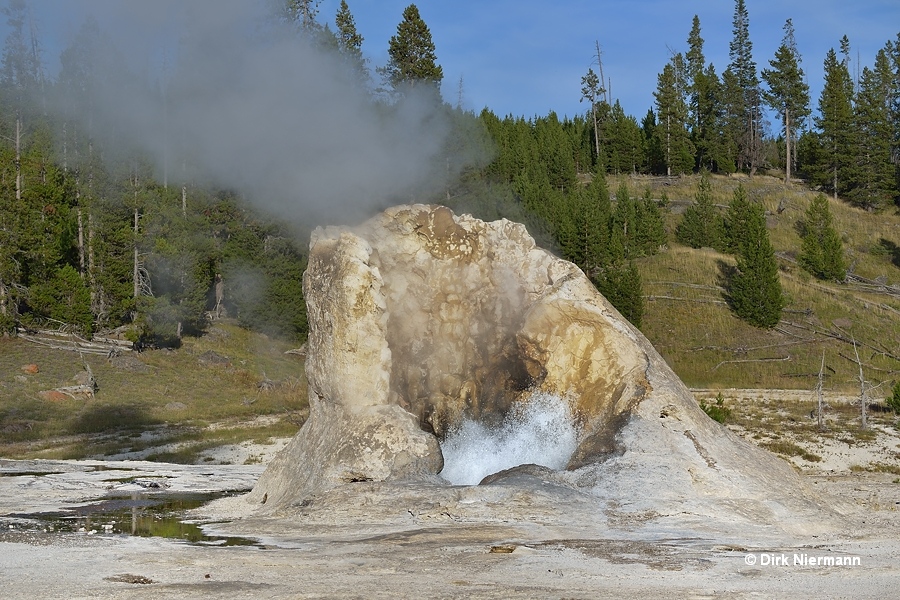
- Giantess Geyser (eruption height up to 61 m (200 feet); 0.8 km / 0.5 miles from Old Faithful parking lot, Upper Geyser Basin)
- Fan Geyser and Mortar Geyser (Fan eruption height up to 38 m (125 feet); 2.3 km / 1.4 miles from Old Faithful parking lot, Upper Geyser Basin)
- Morning Geyser (eruption height up to 45 m (150 feet); 0.4 km / 0.3 miles from Fountain Paint Pot parking lot, Lower Geyser Basin)
- Splendid Geyser (eruption height up to 65 m (215 feet); 1.4 km / 0.8 miles from Old Faithful parking lot, Upper Geyser Basin)
- Excelsior Geyser (eruption height up to 90 m (300 feet); 0.2 km / 0.1 miles from Grand Prismatic Spring parking lot, Midway Geyser Basin)
- Monarch Geyser (eruption height up to 61 m (200 feet); 0.5 km / 0.3 miles from Norris Geyser Basin parking lot, but probably geyser activity has terminated forever)
Backcountry Jewels
These geysers are not round the corner, they require backcountry hiking, and some dangers are included to reach them. An experienced guide is indispensable to first time visitors, as well as bear spray. You will be rewarded with a look at Yellowstone’s geysers and geyser basins as they were at the time of the first explorers. Each of the listed geysers is featuring something exceptional, from unusual activity patterns to spectacularly shaped eruptions to exquisite geyserite formations. However, before starting your hike you should definitely check back with the Backcountry Office whether the targeted area is open to the public.
- Big Bowl Geyser (eruption height up to 7 m (23 feet); 2.5 km / 1.5 miles from Artists' Paintpots parking lot, Gibbon Geyser Basin)
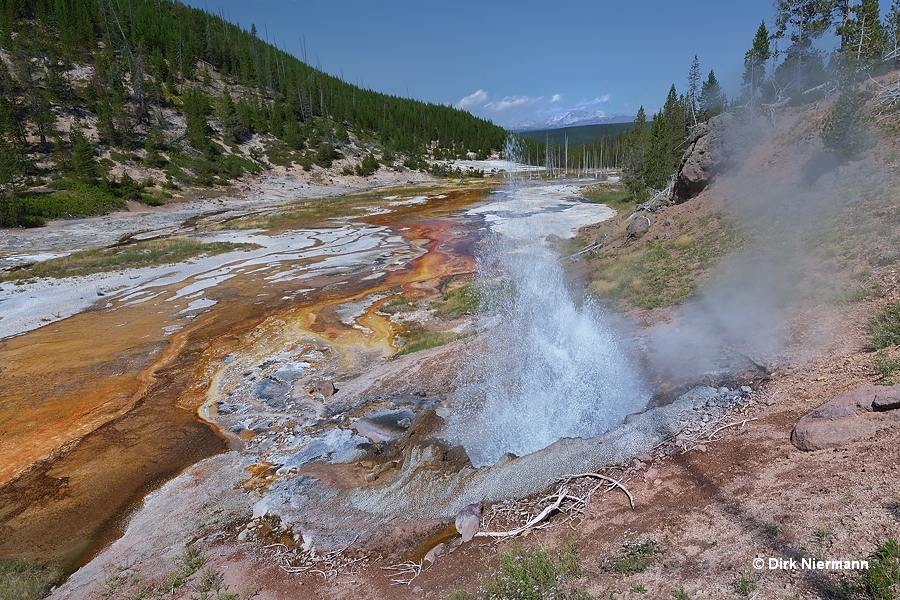
- Minute Man Geyser (eruption height up to 6 m (20 feet); 14 km / 8.7 miles from Kepler Cascades parking lot, Shoshone Geyser Basin)
- Mound Geyser (eruption height up to 3 m (10 feet); 1 km / 0.7 miles from Fountain Flat Drive parking lot, Lower Geyser Basin, but area currently closed)
- Fortress Geyser (eruption height up to 3 m (10 feet); 1.5 km / 1 mile from Fountain Flat Drive parking lot, Lower Geyser Basin, but area currently closed)
- Avalanche Geyser (eruption height up to 7 m (23 feet); 2.5 km / 1.5 miles from Artists' Paintpots parking lot, Gibbon Geyser Basin)
- Crater Hills Geyser (eruption height up to 2.5 m (8 feet); 1.5 km / 1 mile from roadway turnout in Hayden Valley, Hayden Valley Geyser Basin)
- Mangled Crater Spring (eruption height up to 3 m (10 feet); 14 km / 8.7 miles from Kepler Cascades parking lot, Shoshone Geyser Basin)
- Rustic Geyser (13 km / 8.1 miles from Heart Lake Trailhead, Heart Lake Geyser Basin)
Along the trail to your selected destination you may detect many further geysers, which may be not much inferior. Not to forget the countless hot springs and pools with no geyser activity. Often they are displaying a breathtaking play of colors. In particular the complementary contrast between the deep blue color of pure water and the yellow to orange rims, formed by thermophilic organisms, is outstanding. In this respect, Grand Prismatic Spring for sure is the most impressive example.
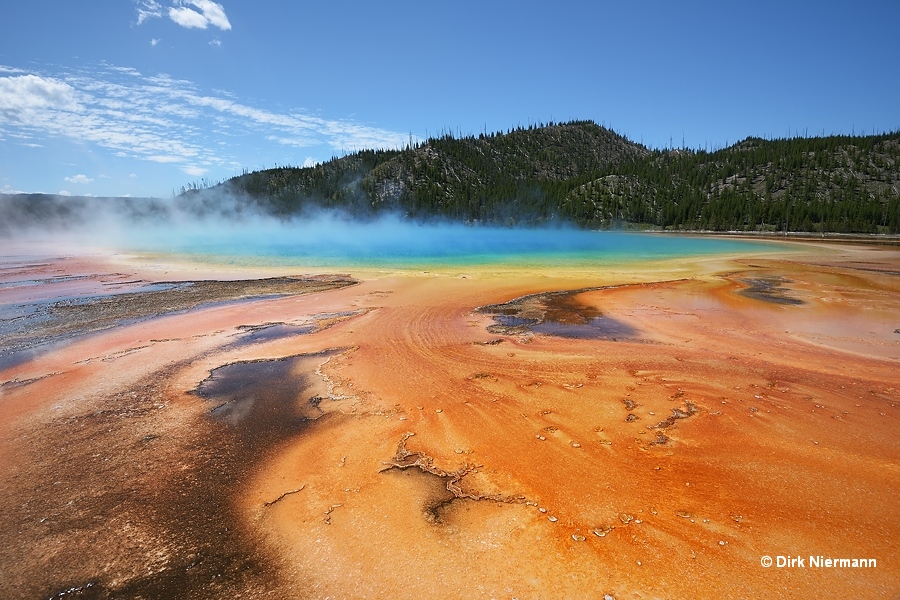
Many longtime Yellowstone insiders have their personal favorites among the geysers, towards which they have established a special relationship. It’s not uncommon for them to pick a lesser known geyser and aiming to learn as much as possible about it on the base of frequent observations. Of course, geysers are no souled beings. But sometimes it is hard to disregard this impression. Geysers come into existence, undergo several stages of life, show individual behavior and temper, and die eventually. Some already after a few hours, others after millennia. They may die from decrepitude, but also from violent self-destruction or from human impact. And it’s a bitter irony that geysers and hot springs sometimes claim human lives in return.
Death Traps
For sure they are nobody's favorites for what happened, but depending on your attitude you may be inclined to visit those hot springs, which took human lives in the past. This is a kind of gruesome tour and far from being everyone's cup of tea. On the other hand, it enhances our awareness of how dangerous hot springs can be if recommended precautions are disregarded.
- Dead Savage Spring (1 km / 0.6 miles from Mary Mountain Trailhead, Lower Geyser Basin)
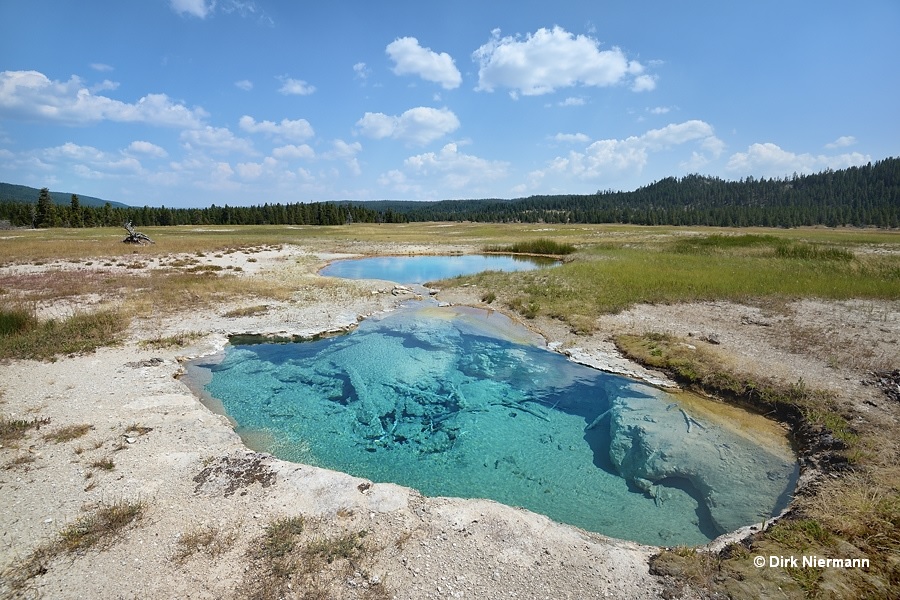
- Crested Pool (1 km / 0.6 miles from Old Faithful parking lot, Upper Geyser Basin)
- Celestine Pool (next to Fountain Paint Pot parking lot, Lower Geyser Basin)
- Cavern Spring (1 km / 0.7 miles from Fountain Flat Drive parking lot, Lower Geyser Basin, but area currently closed)
- Ojo Caliente (0.5 km / 0.3 miles from Fountain Flat Drive parking lot, Lower Geyser Basin)
- SMMGNN014 (14 km / 8.6 miles from Kepler Cascades parking lot, Shoshone Geyser Basin)
- Belgian Pool (1.3 km / 0.8 miles from Old Faithful parking lot, Upper Geyser Basin)
- Turban Geyser (1.4 km / 0.8 miles from Old Faithful parking lot, Upper Geyser Basin)
- Indigo Spring (0.3 km / 0.2 miles from Grand Prismatic Spring parking lot, Midway Geyser Basin)
- Shell Spring (0.3 km / 0.2 miles from Biscuit Basin parking lot, Upper Geyser Basin)
- Jagged Spring (next to Black Sand Basin parking lot, Upper Geyser Basin)
- Abyss Pool (1 km / 0.7 miles from West Thumb parking lot, West Thumb Geyser Basin)
- Orpiment Spring (0.8 km / 0.5 miles from Norris Geyser Basin parking lot, view obscured by trees)